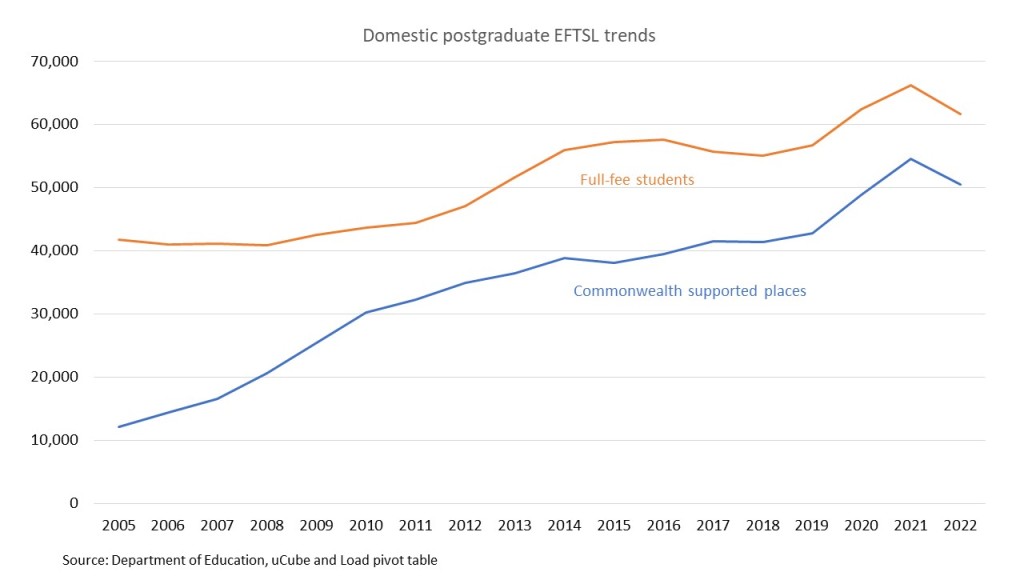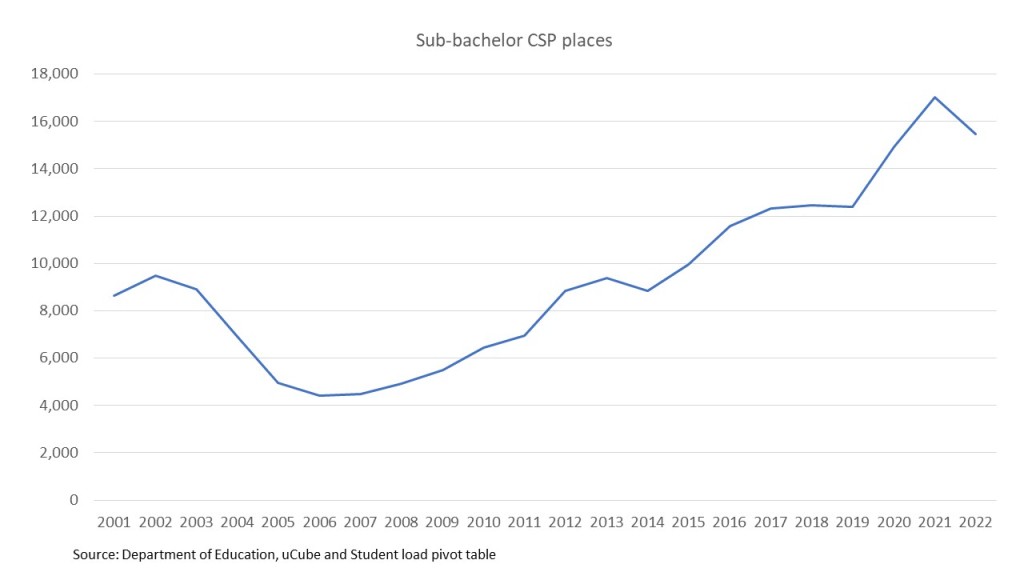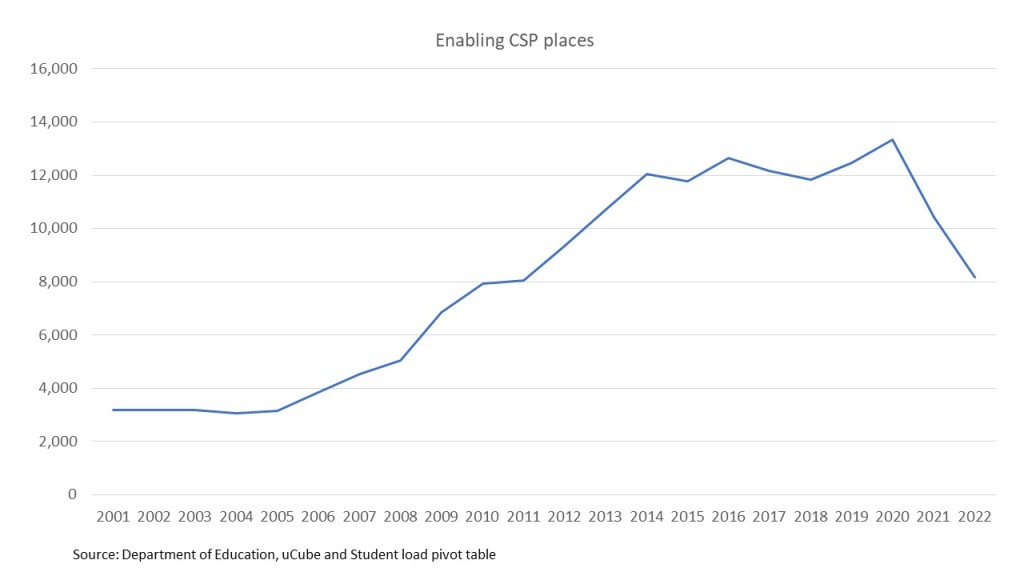Part 1 of this series on the government’s Accord implementation plans looked at the proposed Australian Tertiary Education Commission. Part 2 examined how student places would be allocated between universities. This post considers Accord implementation plans for distributing students places within universities between qualification levels and disciplines. In this post, at least, I find that some of the government’s proposals have merit.
Some background: The government has often allocated higher education resources differently depending on qualification level, course, field of education and sometimes students. This practice can target and/or limit spending on a policy goal. The trade-off is less flexibility in moving resources where they are needed. As a result, prospective students miss out or pay much more than the student contribution rate in the full-fee market.
In the 2010s sub-bachelor, bachelor and postgraduate CSPs were funded separately. Since 2021 they have been funded together, with exceptions for Indigenous bachelor degree students and medical courses.
The distribution of student places between qualification levels – postgraduate
While the Accord final report supported more Commonwealth supported places at the postgraduate level, it wanted to focus them on areas of “national priorities and skills needs”.
The government’s managed growth consultation paper, however, supports the current more flexible system – although as with all flexible allocations in the proposed Accord implementation this will be the default with scope for intervention, discussed later in the post.
Between 2005 and 2020 postgraduate CSP EFTSL expanded, as the chart below shows, but in an ad hoc manner based on government approval. From 2021, under Job-ready Graduates, universities could flexibly move CSPs between qualification levels, although in the chart below the short term COVID-era graduate certificates make any underlying change in CSP patterns harder to discern (pre-COVID PG CSP were 15.9% of CSP load in 2019, 18.4% in 2022).

I remain concerned that potential undergraduates may miss out if too many CSPs are used in postgraduate courses. But reducing how many people accrue significant FEE-HELP debt from full-fee postgraduate courses is also a reasonable policy goal.
The distribution of student places between qualification levels – sub-bachelor
Sub-bachelor award courses – diploma, advanced diploma, associate degree, undergraduate certificate if the latter survives – have a shorter history of CSP control than postgraduates. Sub-bachelor qualifications were last minute exclusions from the demand driven system, but apart from COVID short course places made interchangeable again with bachelor (and postgraduate) places from 2021. This would remain under the proposed Accord system.
Despite being capped (in a pool of places shared with enabling courses, discussed below) in the demand driven era, sub-bachelor places grew significantly, as the chart below shows. As some diplomas are pathways into bachelor degrees in any case, keeping CSPs flexible within undergraduate courses makes sense.

The distribution of student places between qualification levels – enabling
Enabling course CSPs are similarly interchangeable with the award courses in the current system, but with two significant constraints.
No student contribution is charged, with an enabling loading paid in lieu. The Department does not seem to publish the annual indexed enabling loading, but based on the indexation formula I think it is $3,886 per EFTSL in 2024 – less than the lowest actual student contribution this year of $4,445. So there are good financial reasons why a university would not want to offer enabling courses.
If universities do want to offer enabling courses there is no guarantee that they will get any enabling loading. For historical reasons, only some universities get it. The total loading amount implies that there are about 9,800 funded enabling places in 2024.
As the chart below shows, enabling places crashed between 2020 and 2022, with under-enrolment of 16% at the sector level.
The overall weakness of mature age demand is likely to be a significant factor here, with enrolments of enabling students aged 25 years or more dropping 44% between 2020 and 2022.

But the JRG changes also exacerbated the already unfavourable economics of enabling courses by cutting Commonwealth contributions without an offsetting increase in the enabling loading. For example, enabling courses coded to an arts or business field of education would earn the university the Commonwealth contribution of $1,236 plus the $3,886 loading = $5,122 per EFTSL. Obviously that is well short of the funding required for courses aimed at students who need additional assistance.
From a funding perspective the government’s FEE-FREE Uni Ready courses, an enabling course replacement, will make a big difference. These will be funded at a flat $18,279 per EFTSL from 2025, so more than triple the current rate for students taking enabling courses in arts or business fields.
The managed growth consultation paper also says that universities can use FEE-FREE Uni Ready places within their Managed Growth Target (MGT), discussed in the previous post. This means that universities that received no enabling loading can offer FEE-FREE Uni Ready courses. Universities that already have an enabling loading allocated can increase their enrolments on a fully-funded basis.
It remains to be seen if supply-side improvements to enabling courses will be enough to reverse enrolment decline.
The distribution of student places between fields of education
One of my concerns with the direction of the Accord panel during 2023,, and higher education policy more broadly as shown by the 20,000 [sic] equity places and nuclear submarine places, was that we would end up with micromanagement of student places at the course level. A paper I published in 2023 highlighted the risks of this approach.
In the ATEC consultation paper its functions still include “national skills planning in the higher education sector informed by JSA [Jobs and Skills Australia] analysis”.
But the managed growth consultation paper says that “providers would be able to move places between courses … to meet demand from students and industry”.
I read this as saying that ATEC will compare enrolment patterns with skills needs and intervene if necessary. But it will not set itself the massive task of distributing every student place between courses or fields of education.
Intervention via mission-based compacts
The consultation papers do not directly say that student places will be allocated through mission-based compacts, as proposed by the Accord final report. But the ATEC consultation paper does say that “developing enforceable mission-based compacts with links to funding” will be one of its functions.
The managed growth consultation paper says that flexibility at the qualification level and between courses will be “monitored through [with?] negotiation to manage significant shifts in [to?] courses that do not align with national priorities and university missions”.
“Mission-based compact”‘ sounds benign, but in reality these compacts will be powerful tools of direction and enforcement.
Ministerial intervention in the distribution of student places
At the moment, the minister intervenes in the distribution of student places within universities through the funding agreements. Funding agreements are not mentioned in the consultation papers. I expect that they will be replaced by the mission-based compacts.
As I read the consultation papers, the minister will not be a direct party to the mission-based compacts, that will be ATEC’s role. However the minister could direct ATEC to deliver certain results via the compacts.
From the ATEC consultation paper, I can see two ways in which this could occur.
In the annual “statement of expectations” the minister could say that places in X, Y and Z fields should be increased or decreased.
There is also a proposed, but currently vague, ministerial power to direct ATEC on particular matters.
A funding floor
From 2020 to 2023 programs were in place, called a higher education continuity guarantee from 2021, to provide a Commonwealth Grant Scheme funding floor to universities affected by COVID and post-COVID falls in domestic students. The goal, as stated in the grant guidelines, was to “ensure that higher education providers are able to keep operating and employing staff in the aftermath of the COVID-19 pandemic, and to assure the ability of these providers to continue to provide quality education services into the future.”
The government says such a scheme is still in place until the end of 2025, but this is not the case. Instead there is a re-direct of unused CSP funding to an equity program.
Under the pre-2024 guarantee universities were guaranteed at least their “base” maximum basic grant amount (their MBGA minus ad hoc program places) whether they enrolled enough CSPs to justify this amount or not.
The original Accord version of a replacement continuity program proposed using the lower end of each university’s CSP tolerance band as the floor. The current government proposal does not include tolerance bands. Even if the tolerance band idea had survived, with an allocative system that uses EFTSL rather than $$$ there would not have been any fixed funding floor amount.
The government suggests a funding floor of the university’s CGS funding the year before minus x%.
As the consultation paper rightly notes, there are trade-offs here. The floor can help avoid retrenchments that would undermine a university’s longer-term capacity, assuming an enrolment decline reflects short-term issues. But CGS funding not justified by enrolments at one university means lower resources to support actual students elsewhere in the system. The proposed managed decline system for universities persistently not reaching enrolment targets seems sensible.
Not slicing up CGS funding into micro-managed sections will also help. The more conditions that are added to a place (institution, qualification level, course, type of student, etc) the lower the chance a student can be found who matches all the criteria, and the higher the chance that actual enrolments will fall well below the system’s theoretical capacity.
Conclusion
The minister and ATEC would retain significant powers to micro-manage student places. However, it is slightly encouraging that this will not be their default position. The funding floor policy is better than the Accord suggestion and funding enabling places at a higher rate is sensible.